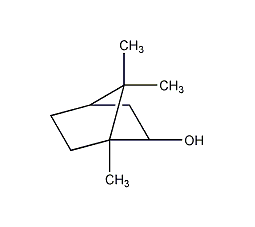
Structural formula
| Business number | 05A5 |
|---|---|
| Molecular formula | C10H18O |
| Molecular weight | 154.25 |
| label |
borneol, 2-Titriol, 1,7,7-Trimethyl-2-endo-hydroxy-bicyclo[2.2.1]heptan, endo-Hydroxybornane, endo-2-Hydroxycamphane, alcohol solvent |
Numbering system
CAS number:507-70-0
MDL number:MFCD00066426
EINECS number:208-080-0
RTECS number:None
BRN number:1903042
PubChem number:24892028
Physical property data
1. Properties: White, translucent crystals with camphor and pine aroma.
2. Density (g/ cm3, 25/4℃): 1.01
3. Relative steam density (g/cm3 , air=1): 5.3
4. Melting point (ºC): 208
5. Boiling point (ºC, normal pressure): 212~214
6. Boiling point (ºC, 8kPa): Not determined
7. Refractive index: Undetermined
8. Flash point (ºC): 65
9. Specific rotation (º): Undetermined
10. Autoignition point or ignition temperature (ºC): Undetermined
11. Vapor pressure (kPa, 25ºC): Undetermined
12. Saturated vapor pressure (kPa, 60ºC): Undetermined
13. Heat of combustion (KJ/mol): Undetermined
14. Critical temperature (ºC): Undetermined
15. Critical pressure (KPa): Undetermined
16. Log value of oil-water (octanol/water) partition coefficient: Undetermined
17. Explosion upper limit (%, V/V): Undetermined
18. Explosion lower limit (%, V/V): Undetermined
19. Solubility: Soluble in alcohol and ether, slightly soluble in water.
Toxicological data
1. Acute toxicity: Rat oral LD50: 500 mg/kg, no detailed instructions except lethal dose;
Mouse oral LD50: 1059 mg/kg, no detailed instructions except lethal dose ;
Rabbit oral LDLo: 2gm/kg, no details except lethal dose;
2. Mutagenicity data: DNA repairTEST system: Bacteria – Bacillus subtilis: 10 mg/disc.
Ecological data
This substance may be harmful to the environment, and special attention should be paid to water bodies.
Molecular structure data
1. Molar refractive index: 45.85
2. Molar volume (cm3/mol): 155.3
3. Isotonic specific volume (90.2K ): 381.2
4. Surface tension (dyne/cm): 36.2
5. Polarizability (10-24cm3): 18.17
Compute chemical data
1. Hydrophobic parameter calculation reference value (XlogP): 2.7
2. Number of hydrogen bond donors: 1
3. Number of hydrogen bond acceptors: 1
4. Number of rotatable chemical bonds: 0
5. Number of tautomers:
6. Topological molecular polar surface area (TPSA): 20.2
7. Number of heavy atoms: 11
8. Surface charge: 0
9. Complexity: 185
10. Number of isotope atoms: 0
11. Determine the number of atomic stereocenters: 0
12. Uncertain number of atomic stereocenters: 3
13. Determine the stereocenter of chemical bonds Number: 0
14. Number of uncertain chemical bond stereocenters: 0
15. Number of covalent bond units: 1
Properties and stability
1. Use and store according to specifications. It will not decompose and avoid contact with oxides.
2. Found in tobacco leaves.
3. (+)-borneol naturally occurs in lavender oil, scented perilla oil, rosemary oil and some camphor oils. (-)-borneol is found in essential oils such as coriander oil, citronella oil, and turpentine.
4. It has certain toxicity, irritation and allergic reactions.
Storage method
Stored in a cool, dry and well-ventilated warehouse. Keep away from fire and heat sources. Protect from direct sunlight. The packaging is sealed. They should be stored separately from acids and food chemicals, and avoid mixed storage. Suitable materials should be available in the storage area to contain spills.
Synthesis method
1. Prepared by dissolving camphor in ethanol and reducing it with metallic sodium or with new ecological hydrogen.
2. Synthesis: α-pinene is first treated with hydrogen chloride, and after molecular rearrangement, it generates chloroborneol. After treatment with alkali, it becomes pinene, and then it is added with acetic acid to transform into isoacetic acid. Bornyl ester is obtained by saponification and hydrolysis of isobornyl acetate and its isoform structure; method two: first convert α-pinene into chloroborneol, and then undergo Grignard reaction, oxidation, and hydrolysis. Made into borneol.
Purpose
1. GB 2760-1996 stipulates that edible spices are allowed to be used. Mainly used for preparing mint, white lemon and nut flavors. 2. Used as biochemical reagents and also in the pharmaceutical industry. 3. Widely used in the preparation of rosemary, lavender and other flavors, and used in combination In pharmaceuticals, etc. 4. It is also mainly used in fragrances such as cleaners, detergents, insect repellents, and inks. 5. Used as a special additive for therapeutic cosmetics. Used in toilet water, etc.

 微信扫一扫打赏
微信扫一扫打赏

